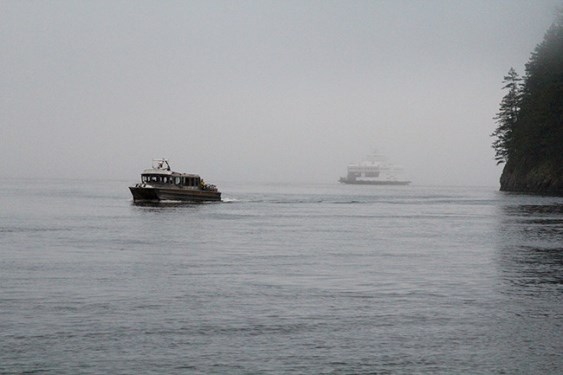On his way to the Bowen Island Municipal Hall for Monday’s 1 p.m. Council of the Whole meeting, Mike Buda, the Interim Executive Director of the Metro Vancouver Mayor’s Council, rode the 257 express bus from downtown Vancouver, crossed Howe Sound on The Bowen Queen, and hiked up the hill to Artisan Lane. Buda came to council to explain his perspective on why Bowen Islanders should vote in favour of creating a “congestion improvement tax” that would create a 0.5 percent regional sales tax to fund transportation that will accommodate 1 million new residents in Greater Vancouver by 2040.
Buda told council that greater Vancouver has done a good job managing population growth and traffic over the past decade, keeping traffic levels flat while population has increased 18 – 20 percent. However, Buda explained a situation he called “Peak Bus” as the kind of problems the Mayor’s Council sought to address with its transportation plan. Between the 1990s and 2009, he said, bus service hours saw a steady per-capita increase. But because TransLink’s revenues are locked in, in 2009 that trend started to reverse and would result in bus service hours returning to 2007 levels within 10 to 15 years.
Buda explained that creating an integrated transportation plan for all the 22 municipalities within Metro Vancouver was necessary because people travel so much across the region. The fact that 60 percent of Bowen residents commute to work every day is the average in the region, he said, but what sets Bowen apart is its slow rate of population growth. The Mayor’s Council plan targets its major investments at fast-growing communities that are falling behind fast on transportation needs.
If a “yes” vote wins in the upcoming referendum, Buda says one of the first changes to be implemented in to the Greater Vancouver transit system would be to increase in bus service hours per-capita. Because of this, Bowen Islanders travelling to Vancouver would be greatly impacted.
“Specifically for Bowen, by 2016, we’re going to increase mid-day and weekend service for the 250 and 257. The reason we can do that is because during off-peak hours, TransLink has plenty of buses and plenty of drivers… what TransLink lacks is the funding to pay for the drivers and pay for the fuel in those off-peak hours.”
Buda added that within three years, the 250 will run every 20 minutes all day and through the evening, and the 257 would likely run every 12 minutes during peak hours.
Buda also pointed to a survey being put out by Bowen’s Transportation Advisory Committee (BIMTAC) to learn more about how islanders are using the 250 and the 257, and making connections with BC Ferries.
“Solutions are a lot easier when there are additional resources at play,” Buda told council.
Within six years, Buda said, we’ll see an extension of the Bowen Island C-11 bus to Hood Point. He added that if this plan does not make sense in five years time, then the resources can be allocated elsewhere.
Following Buda’s presentation, council members brought up the success of Peter King’s commuter Express Bus, and noted that the extension of bus service to Cowan Point would be valuable. Audience member Chris Corrigan asked Buda whether different experimenting with different transportation solutions, like a water taxi to downtown Vancouver, could come under some kind of transportation piloting program under the Mayors Council Transportation Plan.
“As I said before, it’s always easier to experiment when you have additional resources,” said Buda. “The funding that is dedicated to increasing walking and cycling is massive, I suspect that there’s going to be some room there, especially, for different municipalities to have better services. In a water taxi, people are not in their cars, by definition, so I think that there will be a lot of possibility there.”
Buda says that the Mayors Council will be releasing an action plan with more specific details in the coming weeks, and at the request of Councillor Mason, he will send out a press release detailing specifics related to Bowen Island as has been done with other communities.
Transportation & Mayors Council Plan Fun Facts:
- The Mayors’ plan will increase capacity of SkyTrain up to 25,700 passengers per hour, per direction, which is the equivalent to 10 highway traffic lanes per direction….so, the same as a 20 lane highway, which is double the width of Hwy 1 at its widest point today!
- The plan will include an additional $131m in regional funds for cycling improvements over the next 10 years, bringing the total to $152m. This is a 600+% increase in funding from the current $20.94m. The plan also includes $35m in regional funds for improving walking access to transit stops and stations over the next 10 years.
- The Mayors’ plan includes 11 new B-Line (Express) buses, three of which will be on the North Shore.



